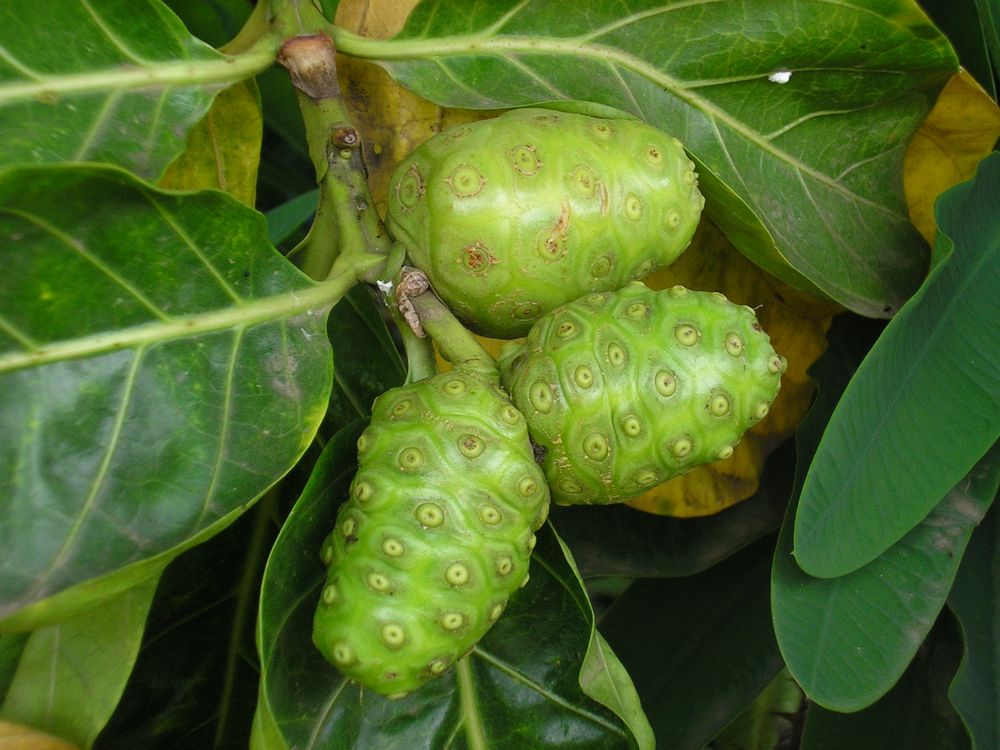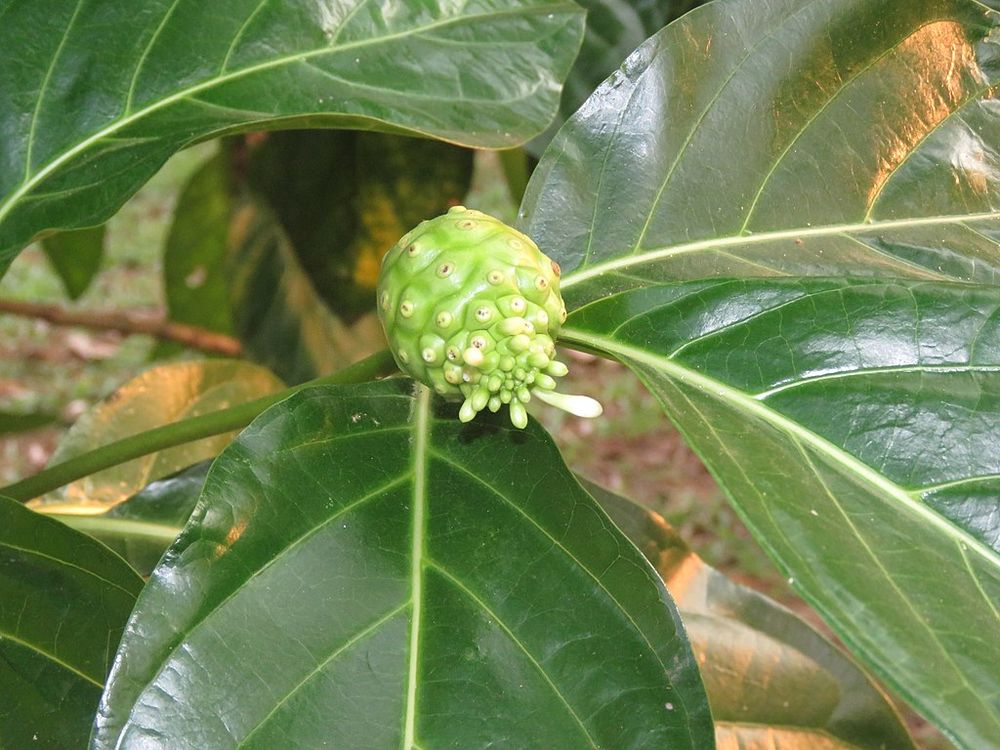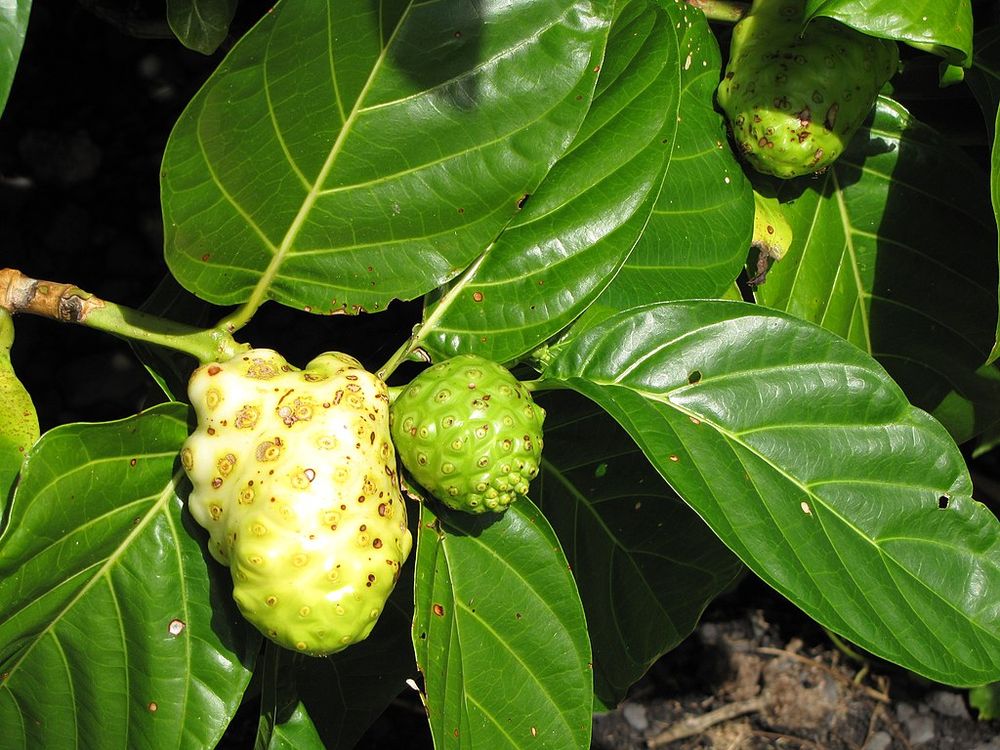Noni is a small tree with elliptical, hairless, shiny leaves. Its flowers are white. The fleshy fruit is made up of small, light green berries that are fused together. This tree originated in India and is widely distributed in Asia, the Pacific and the New World. Its name noni is the name given to it in Tahiti; more precisely, it is the name of the juice extracted from it, which is marketed throughout the world. Its fruits are edible but their cheesy smell is not to everyone’s taste.
In Laos, the leaves are used against infantile diarrhoea, and finger and toe pain; the green fruit treats ulcers, swellings of the mouth and tongue, and “windy blood” (luat lom); the roots are said to be effective against tetanus.
In addition, the leaves, bark and wood give a yellow or red dye with an alum mordant. The pulp of the fruit is used to clean hair and metal. This tree is sometimes used as a shade for coffee cultivation.
In Laos you will often see noni trees in gardens because its name, gno, means “to carry”, and “to support” and it is believed that this small tree can help us in the difficulties of life.
The juice of the ripe noni fruit is difficult to obtain by squeezing due to the presence of a large amount of mucilaginous material, but after freezing and breaking up the cell structures and then grinding, an acidic liquid (pH 3 to 4) is easily collected which is very little fermentable. This juice is fashionable and is considered a panacea in many regions. According to a small group of American researchers, it contains substances that can delay the ageing of the skin, arthritic inflammations, or protect the body against degenerative diseases such as cancer! But the chemical and pharmacological data are fragmentary and not always verified. Although noni is not a harmful plant, it does not cure all diseases. This brings us to the problem posed by traditional medicines, which are gentle medicines, without major side effects, but in certain serious cases, insufficient.
Le noni est un petit arbre aux feuilles elliptiques, glabres, luisantes. Ses fleurs sont blanches. Le fruit charnu est formé de petites baies d’un vert pâle, soudées entre elles. Cet arbre originaire d’Inde est largement répandu en Asie, dans le Pacifique et dans le nouveau monde. Son nom noni est celui qui lui est donné à Tahiti; plus exactement c’est le nom du jus qui en est extrait et qui est commercialisé dans le monde entier. Ses fruits sont comestibles mais leur odeur de fromage ne plaît pas à tout le monde.
Au Laos les feuilles sont utilisées contre la diarrhée infantile, les douleurs des doigts ou des orteils; le fruit vert soigne les ulcérations, les enflures de la bouche et de la langue, « le sang venteux » (luat lom); les racines seraient efficaces contre le tétanos.
Par ailleurs les feuilles, l’écorce et le bois donnent une teinture jaune ou rouge avec un mordant à l’alun. La pulpe du fruit est employée pour nettoyer les cheveux et le métal. Cet arbre sert parfois d’ombrage pour la culture du café.
Vous verrez souvent au Laos des pieds de noni dans les jardins car son nom, gno, signifie « porter », « soutenir » et l’on pense que ce petit arbre peut nous aider dans les difficultés de la vie.
Le jus du fruit mûr de noni est difficile à obtenir par pression à cause de la présence d’une grande quantité de matières mucilagineuses, mais après congélation et éclatement des structures cellulaires puis broyage, on recueille facilement un liquide acide (pH 3 à 4) qui est très peu fermentescible. Ce jus est à la mode, il est considéré comme une panacée dans de nombreuses régions. En effet selon un petit groupe de chercheurs américains, il contient des substances pouvant retarder le vieillissement de la peau, les inflammations arthritiques, ou protéger l’organisme contre les maladies dégénératives telles que le cancer ! Cependant, les données chimiques et pharmacologiques sont fragmentaires et pas toujours vérifiées. Si le noni n’est pas une plante nocive, pour autant elle ne guérit pas toutes les maladies. On touche ici au problème posé par les médecines traditionnelles qui sont des médecines douces, sans gros effets secondaires, mais dans certains cas graves, insuffisantes.



Noni is a small tree with elliptical, hairless, shiny leaves. Its flowers are white. The fleshy fruit is made up of small, light green berries that are fused together. This tree originated in India and is widely distributed in Asia, the Pacific and the New World. Its name noni is the name given to it in Tahiti; more precisely, it is the name of the juice extracted from it, which is marketed throughout the world. Its fruits are edible but their cheesy smell is not to everyone’s taste.
In Laos, the leaves are used against infantile diarrhoea, and finger and toe pain; the green fruit treats ulcers, swellings of the mouth and tongue, and “windy blood” (luat lom); the roots are said to be effective against tetanus.
In addition, the leaves, bark and wood give a yellow or red dye with an alum mordant. The pulp of the fruit is used to clean hair and metal. This tree is sometimes used as a shade for coffee cultivation.
In Laos you will often see noni trees in gardens because its name, gno, means “to carry”, and “to support” and it is believed that this small tree can help us in the difficulties of life.
The juice of the ripe noni fruit is difficult to obtain by squeezing due to the presence of a large amount of mucilaginous material, but after freezing and breaking up the cell structures and then grinding, an acidic liquid (pH 3 to 4) is easily collected which is very little fermentable. This juice is fashionable and is considered a panacea in many regions. According to a small group of American researchers, it contains substances that can delay the ageing of the skin, arthritic inflammations, or protect the body against degenerative diseases such as cancer! But the chemical and pharmacological data are fragmentary and not always verified. Although noni is not a harmful plant, it does not cure all diseases. This brings us to the problem posed by traditional medicines, which are gentle medicines, without major side effects, but in certain serious cases, insufficient.
Le noni est un petit arbre aux feuilles elliptiques, glabres, luisantes. Ses fleurs sont blanches. Le fruit charnu est formé de petites baies d’un vert pâle, soudées entre elles. Cet arbre originaire d’Inde est largement répandu en Asie, dans le Pacifique et dans le nouveau monde. Son nom noni est celui qui lui est donné à Tahiti; plus exactement c’est le nom du jus qui en est extrait et qui est commercialisé dans le monde entier. Ses fruits sont comestibles mais leur odeur de fromage ne plaît pas à tout le monde.
Au Laos les feuilles sont utilisées contre la diarrhée infantile, les douleurs des doigts ou des orteils; le fruit vert soigne les ulcérations, les enflures de la bouche et de la langue, « le sang venteux » (luat lom); les racines seraient efficaces contre le tétanos.
Par ailleurs les feuilles, l’écorce et le bois donnent une teinture jaune ou rouge avec un mordant à l’alun. La pulpe du fruit est employée pour nettoyer les cheveux et le métal. Cet arbre sert parfois d’ombrage pour la culture du café.
Vous verrez souvent au Laos des pieds de noni dans les jardins car son nom, gno, signifie « porter », « soutenir » et l’on pense que ce petit arbre peut nous aider dans les difficultés de la vie.
Le jus du fruit mûr de noni est difficile à obtenir par pression à cause de la présence d’une grande quantité de matières mucilagineuses, mais après congélation et éclatement des structures cellulaires puis broyage, on recueille facilement un liquide acide (pH 3 à 4) qui est très peu fermentescible. Ce jus est à la mode, il est considéré comme une panacée dans de nombreuses régions. En effet selon un petit groupe de chercheurs américains, il contient des substances pouvant retarder le vieillissement de la peau, les inflammations arthritiques, ou protéger l’organisme contre les maladies dégénératives telles que le cancer ! Cependant, les données chimiques et pharmacologiques sont fragmentaires et pas toujours vérifiées. Si le noni n’est pas une plante nocive, pour autant elle ne guérit pas toutes les maladies. On touche ici au problème posé par les médecines traditionnelles qui sont des médecines douces, sans gros effets secondaires, mais dans certains cas graves, insuffisantes.






Noni is a small tree with elliptical, hairless, shiny leaves. Its flowers are white. The fleshy fruit is made up of small, light green berries that are fused together. This tree originated in India and is widely distributed in Asia, the Pacific and the New World. Its name noni is the name given to it in Tahiti; more precisely, it is the name of the juice extracted from it, which is marketed throughout the world. Its fruits are edible but their cheesy smell is not to everyone’s taste.
In Laos, the leaves are used against infantile diarrhoea, and finger and toe pain; the green fruit treats ulcers, swellings of the mouth and tongue, and “windy blood” (luat lom); the roots are said to be effective against tetanus.
In addition, the leaves, bark and wood give a yellow or red dye with an alum mordant. The pulp of the fruit is used to clean hair and metal. This tree is sometimes used as a shade for coffee cultivation.
In Laos you will often see noni trees in gardens because its name, gno, means “to carry”, and “to support” and it is believed that this small tree can help us in the difficulties of life.
The juice of the ripe noni fruit is difficult to obtain by squeezing due to the presence of a large amount of mucilaginous material, but after freezing and breaking up the cell structures and then grinding, an acidic liquid (pH 3 to 4) is easily collected which is very little fermentable. This juice is fashionable and is considered a panacea in many regions. According to a small group of American researchers, it contains substances that can delay the ageing of the skin, arthritic inflammations, or protect the body against degenerative diseases such as cancer! But the chemical and pharmacological data are fragmentary and not always verified. Although noni is not a harmful plant, it does not cure all diseases. This brings us to the problem posed by traditional medicines, which are gentle medicines, without major side effects, but in certain serious cases, insufficient.
Le noni est un petit arbre aux feuilles elliptiques, glabres, luisantes. Ses fleurs sont blanches. Le fruit charnu est formé de petites baies d’un vert pâle, soudées entre elles. Cet arbre originaire d’Inde est largement répandu en Asie, dans le Pacifique et dans le nouveau monde. Son nom noni est celui qui lui est donné à Tahiti; plus exactement c’est le nom du jus qui en est extrait et qui est commercialisé dans le monde entier. Ses fruits sont comestibles mais leur odeur de fromage ne plaît pas à tout le monde.
Au Laos les feuilles sont utilisées contre la diarrhée infantile, les douleurs des doigts ou des orteils; le fruit vert soigne les ulcérations, les enflures de la bouche et de la langue, « le sang venteux » (luat lom); les racines seraient efficaces contre le tétanos.
Par ailleurs les feuilles, l’écorce et le bois donnent une teinture jaune ou rouge avec un mordant à l’alun. La pulpe du fruit est employée pour nettoyer les cheveux et le métal. Cet arbre sert parfois d’ombrage pour la culture du café.
Vous verrez souvent au Laos des pieds de noni dans les jardins car son nom, gno, signifie « porter », « soutenir » et l’on pense que ce petit arbre peut nous aider dans les difficultés de la vie.
Le jus du fruit mûr de noni est difficile à obtenir par pression à cause de la présence d’une grande quantité de matières mucilagineuses, mais après congélation et éclatement des structures cellulaires puis broyage, on recueille facilement un liquide acide (pH 3 à 4) qui est très peu fermentescible. Ce jus est à la mode, il est considéré comme une panacée dans de nombreuses régions. En effet selon un petit groupe de chercheurs américains, il contient des substances pouvant retarder le vieillissement de la peau, les inflammations arthritiques, ou protéger l’organisme contre les maladies dégénératives telles que le cancer ! Cependant, les données chimiques et pharmacologiques sont fragmentaires et pas toujours vérifiées. Si le noni n’est pas une plante nocive, pour autant elle ne guérit pas toutes les maladies. On touche ici au problème posé par les médecines traditionnelles qui sont des médecines douces, sans gros effets secondaires, mais dans certains cas graves, insuffisantes.


